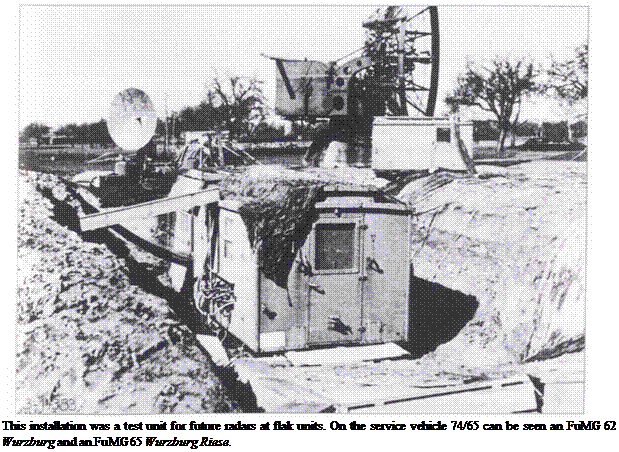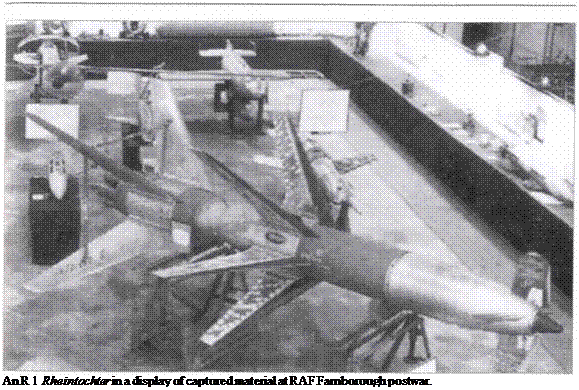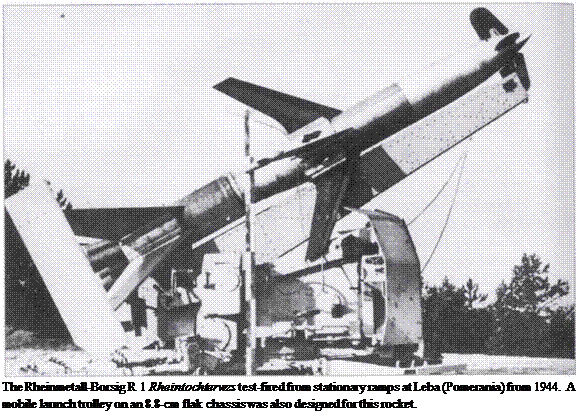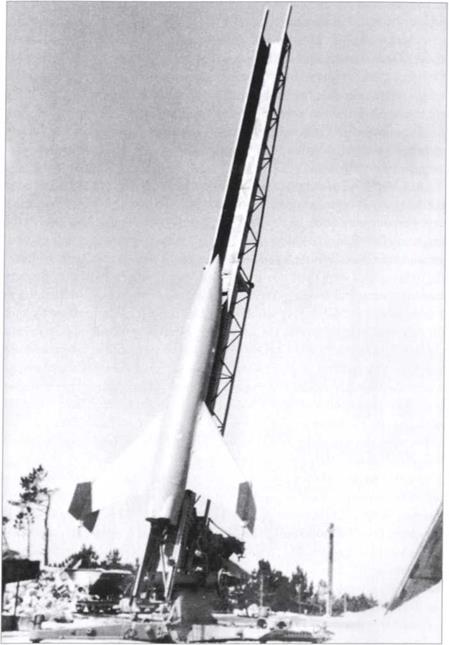Planning to the Bitter End
On 29 October 1941 the first concrete plans for new anti-aircraft weapons were put before the RLM. The flak rocket had an important advocate in Generalmajor Walther von Axthelm, commander of I. Flakkorps, but a number of technical problems prevented a breakthrough. In December 1941 Goring intervened personally against the idea. Along with many of his Great War contemporaries, he believed that Bf 109-equipped fighter squadrons and plenty flak guns were all that would ever be necessary for the air defence of the Reich. At the end of 1941, Generalleutnant Otto Wilhelm von Renz, Commander I. Flakdivision, reported to the HWA that the amount of ammunition expended per enemy aircraft destroyed was disproportionately high, and would deteriorate further as the enemy built faster machines. For each victory, German flak needed: 16,000 8.8-cm (Flak 36) rounds, or 6,000 10.5-cm (Flak 39) rounds, or 3,000 12.8-cm (Flak 40 rounds).
Replacing this wastage, each single flak rocket would either damage or destroy an aircraft. General von Renz was aiming to abandon range/height prediction
|
The F 25 and F 55 Feuerlilie flak rockets were only fired experimentally. |
formulae in favour of target blanketing, and radar – or radio-controlled flak rockets. In a conference on 6 December 1941 at the Ministry of Aircraft Supply, however, it was decided that rocket-powered interceptor fighters such as the
Fi 166 should be the standard anti-aircraft weapon. Only when a rocket was perfected with a 100 per cent certainty of a hit could this decision be reviewed.
In March 1942 the Flak Rocket Division was set up at Flak Defence Group under Oberstleutnant Dr Haider, and on 5 March Reichsminister Speer called for flak rocket development to be forced through with all energy. This led a month later to the first flak programme to include flak rockets. Because of the rapid growth in Allied aircraft production, the General Inspector of Flak Artillery, General der Flakwaffe von Axthelm, made emphatic demands for flak rockets on the grounds that both the war, and flak rocket development, were likely to be lengthy.
On 5 May 1942 Speer spoke out again on the importance of carrying through the flak programme to completion, and especially flak rocket development. Since new weapons were often greeted with scepticism at the highest level, and in the summer of 1942 it was known that the flak rocket production plan was not presently practical because it required more raw materials than were available, the deliberations were therefore drawn out. Design work on individual projects, interim testing and test-stand trials all made slow progress. Nevertheless, on 1 September 1942 Goring signed the Flak Development Programme which for the first time included rockets for air defence. These were initially spin-stabilised solid-fuel rockets: later some kind of guidance element would be introduced and finally an independent target-finding system. Although General von Axthelm was made project head, Goring appointed himself the ultimate arbiter and gave the OKL command staff the job of drawing up the tactical and technical guidelines for the future weapon. By now Goring was of the opinion that in three to five years the flak rocket would probably be the only ground-based defensive weapon of use against long-range bombers.
On 10 October 1942, a good five years after anti-aircraft rockets were first seriously discussed, the development programme came to HAP (Homeland Artillery Park) 11 at Peenemiinde, and was explained to Wernher von Braun two days later. On 22 October OKL made known its tactical and technical requirements for the flak rocket. They wanted a target-seeking flak rocket which homed in on the aircraft when near it or better still a radio-controlled, two-stage solid-fuel rocket with a 100-kg warhead. Although no experimental models were available, on 27 October a flak rocket test command was established at Peenemiinde responsible to the Army Experimental Institute (HVA).
Meanwhile Braun and Dornberger had given thought to flak rocket types, leading to the concept of a midget A-4 designated Wasserfall. In a conference on 5 November 1942, General von Axthelm convinced his audience of the importance of the flak rocket. The greatest problem was guidance. Procedures using the Lichtenstein radar, infra-red and passive homing using emissions from electronic equipment aboard enemy aircraft were all mentioned. General von
Renz reported on problems constructing the test stand because supplies of building steel had not increased. On 5 February 1943 a new contract was placed for the supply, and on 17 February Goring approved the construction of Test Stand IX following talks with General von Axthelm. The project was awarded a high priority which attracted funds, and two days later OKL budgeted RM.500,000. A further controversy hindered progress when the RAD (Reichsarbeitsdienst) unit handling the construction was withdrawn in April at short notice. Wrangling ensued over whether another RAD unit or forced labour from the east should be employed, and work did not resume until mid-July. The authorities were concerned that too few staff were employed on the targetseeking rocket, and on 6 August 1943 after arguments between OKH and OKL had been resolved, a number of Army personnel engaged on developing the A-4 (V-2) were switched to the Luftwaffe project.

After the devastating air attack on Peenemiinde on the night of 18 August 1943, an urgent discussion considered evacuating the entire flak rocket
development away from Peenemiinde for security reasons, but as the infrastructure was in place it was decided to remain. Most of the technical staff needed by the experimental commando arrived at Karlshagen near Peenemiinde at the beginning of September 1943. What the specialists were to concentrate on was not clear, and further talks with Milch produced no solution on what guidance system was to be developed. On 13 September Milch received the Plenipotentiary for Remote Guidance Research, Professor Friedrich Gladenbeck, who advised that work on the ground-to-air rocket should be abandoned because the air-to-air rocket was simpler and cheaper to produce. But since nobody could decide for certain between two theoretical ideas, the research was instead allowed to proceed down both avenues.
Meanwhile some advances had been made in the technology, and by 15 December 1943 the launchers for the Enzian, Schmetterling, Rheintochter and Wasserfallrockets had been designed. Before the years end both a Feuerlilie (F 25) and a Rheintochter (R 1) had been test-fired, the latter at Test Stand IX. Test firings of the Schmetterling and Enzian were scheduled for the coming weeks. During this critical phase, jurisdiction in armaments was vested in Speer as Minister for Armaments and War Production, who thus became responsible for all air armament projects. The Army, Luftwaffe and armaments groups struggling for more power were now joined by Reichsfuhrer-SS Himmler. He began his campaign at Peenemiinde on 21 February 1944 by attempting to recruit Wernher von Braun to the SS and so expand SS influence on rocket production generally. This move would have isolated General Dornberger. Brauns refusal led to his arrest by the Gestapo on 15 March 1944 for ‘suspected sabotage of V-weapons’. He was detained for a fortnight, but jurisdiction remained with the Army and Luftwaffe.
In April 1944 the experimental Enzian was test-fired from Stand IX at Peenemiinde followed by the first test-firing of Feuerlilie (F 55) on the Greifswalder Oie. The two Feuerlilie versions, F 25 and F 55, were considered to have great promise for future development. The project was revised in the summer of 1944 at Karlshagen with particular emphasis on the problems of control, and on 26 June 1944 an organisational plan worked out. For security reasons HAP 11 was given the cover name ‘Elektromechanische Werke GmbH Karlshagen and provided with virtual autonomy.
On 1 August 1944 a conference with Reichsminister Speer considered the rounds per kill ratio of traditional flak artillery. The extremely high cost of shooting down an enemy aircraft by artillery as against the hypothetical possibility of destroying one bomber with every target-seeking rocket, with all its attendant savings in raw materials was found compelling. On 8 August a comparison was made between the 12.8-cm Flak 40 gun and the as yet most expensive, liquid-fuelled flak rocket Wasserfall. Greater effort was now invested

in the infrastructure for batteries of flak rockets, and on 18 August OKL submitted its design for a cabling system while experts worked to design automatic devices to home in on Allied H2S or H2X ground-mapping radar.
On 9 August 1944 the Completion Committee for Flak Rocket Construction decided that the Schmetterling and Wasserfall were the most promising projects and their pace of development should be stepped up while the Committee would be kept informed regarding Enzian, Rheintochter (R 3) and various other missiles. In order to guarantee production, the Buchenwald satellite camp Mittelbau was made independent at Nordhausen and in time 30 outworker parties assembled. These prisoners were to create the infrastructure for V-2 and flak-rocket production in large underground workshops in the Himmelberg (Woffleben) and Kohnstein (Niedersachswerfen). Thousands of prisoners died in the appalling conditions.
On 30 October 1944 at Peenemiinde Speer witnessed the firing of flak rockets for the first time. After watching the start of two Wasserfall from Stand IX, he decided immediately that the project should be continued together with research into the supersonic possibilities. He also said that Rheintochter should be further tested although he had not seen this rocket fired. The two subsonic missiles, Enzian and Schmetterling, on the other hand should be completed as soon as

possible and made operational. Another prospect was the Taifun, which to everybody’s surprise Goring had classified as important. On 4 November 1944 in compliance with Hider’s order work was stepped up on the production of flak ammunition and new rockets, while Speer (and later Himmler) received instructions to guarantee individual types. To consolidate the ground organisation for the various rocket designs, a number of modifications were introduced: for example, from mid-November 1944 the same launcher could be used for the Enzian or Rheintochter. The Wasserfall launcher did not have a revolving turntable, and for the comparatively light Hs 117 Schmetterling only a very light firing assembly was needed.
It was clear that the protective screen of flak rockets would not extend to cover the whole area of the Reich and for this reason on 6 December 1944 the order was given to erect emplacements in central Germany to protect important industrial installations, particularly oil refineries and the synthetic fuel factories. A limited number of cities would also be included in the screen. Despite the ever-worsening situation no decision had been taken by the end of December as
to which flak rockets should be produced, even though some were bound to be abandoned for lack of raw materials. Because of reservations about Schmetterling, OKL decided to press forward with Wasserfall, since this was based on the already proven A-4 artillery rocket.
On 5 January 1945 Speer decreed immediate measures for air defence in which, besides the greatest possible increase in the production of flak guns and ammunition of all kinds, preparations should be made for flak rocket mass production, and Arbeitsstab Dornberger was formed on 12 January to push ahead with flak rocket development. Based at Schwedt on the Oder, it was to provide coordination. On 14 January Gruppenfuhrer Kammler took overall charge of V-weapons production on Hitler’s order, this being Himmler’s first step in his attempt to bring all ‘high-technology weapons’ under his own control. On 27 January Arbeitsstab Dornberger met to choose whichever rocket would be readied first, and next day Himmler ordered all flak rocket work to be concentrated at Mittelwerk near Nordhausen in order to protect the programme in the underground factories there. The transfer caused a four-week delay before the schedule resumed, but the need for the measure spoke for itself.
When Peenemiinde and Karlshagen were partially evacuated on 31 January 1945, Himmler gave Kammler command of Armeekorps zbV (‘for special purposes’) which now became the overseer of all rocket warfare. At the beginning of February Arbeitsstab Dornberger was forced by the military situation to remove from Schwedt to Bad Sachsa. As an immediate measure OKL relinquished 5. Flakdivision to the Waffen-SS to begin flak rocket operations. For this purpose the ‘Luftwaffe Staff to Break the Air terror’ was formed and transferred to the Harz Trutzgau, the ‘Defensive region of the Reich’. On 6 February Himmler issued a comprehensive order regarding the use of giant rockets (like the V-2) and the further development of flak rockets. All projects not close to final testing were to be discontinued. Only a smaller version of Wasserfall, the basic Schmetterling and the non-guided, spin-stabilised Taifun thus survived.
Riistungsstab leader Saur went to Mittelwerk in mid-February 1945 to help coordinate flak-rocket development. Besides moving Elektromechanische Werke GmbH from Karlshagen to Nordhausen, he ordered the motor department of the Hellmuth Walter firm to transfer to Bleichrode in the southern Harz. On 17 February 1945 the evacuation of Peenemiinde began in earnest and the first train to leave the installation headed for Nordhausen. Despite these steps, it was obvious from the Reich Research Council conference on 26 February, when the possibilities of overcoming the ‘air terror’ were discussed, that no flak rocket would be operational until late summer 1945, should the fronts hold that long. Nevertheless, development went on, and on 28 February Arbeitsstab Dornberger met to consider the use of rangefinders and target computers although the possibility of turning out this kind of complex equipment was very doubtful.
In March the transfer of HVA Peenemiinde and the Karlshagen annexe was concluded with the evacuation of the remaining technical personnel. All development work on flak rockets was now abandoned except for the non-guided Taifun and the radio-controlled Wasserfall, Schmetterling and Enzian having been struck from the Fiihrer-Programme. SS-Gruppenfuhrer Kammler accumulated more titles when, in addition to his other offices, he was made ‘Commissioner for Jet Aircraft’and on 17 March ‘Fiihrer’s Commissioner to Break the Bombing Terror’. This meant that Himmler had reached his goal of directing and controlling air armaments, on paper at least, so far as the situation allowed.
On 3 April 1945 Arbeitsstab Domberger moved from Bad Sachsa to Ober – ammergau in Upper Bavaria. Next day probably the last Jagerstab conference was chaired by Saur. The talk was centred on jet aircraft and the hopes for flak rockets in the short term. In view of the collapsing fronts there was little optimism. The same day in a heavy air raid on Nordhausen and the surface area of Mittelwerk there was serious loss of life amongst townspeople and camp prisoners, and serious material damage. As a result, 24 hours later a start was made to transfer the most important rocket and weapons specialists from Nordhausen to Oberammergau and other destinations in Bavaria. Leading scientists moved for the last time aboard the ‘Reprisal Express’as they jokingly termed it. On 10 April 1945 American forces arrived at Bleichrode and occupied the ruins of Nordhausen. Next day they stood before the open gates of the formerly top secret Mittelwerk.











